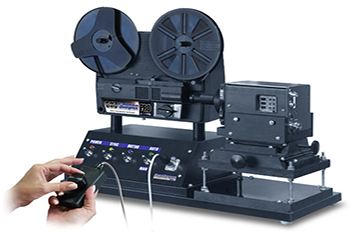
Film Conversion Equipment
Film Scanning and Film Transfer Equipment Types
The type of film scanning machine used for your 8mm, Super 8 or 16mm film conversion will have as much of an impact on the quality you receive as the resolution of the scan itself will. For example, if you wanted to digitize a photograph and tried doing it two different ways. You first put the photograph down on a table and took a picture of it using your smart phone or camera. Then you took the picture and scanned it using a flatbed scanner. If you compare the two side by side on your computer it will become really obvious that the flatbed scanner produced a digital image as good as the photograph. However, the picture you took with your phone or camera does not look close to the quality of the original photograph.
The same goes for scanning your 8mm, Super 8 or 16mm film. The real-time and frame by frame machines below are using a camcorder to take a picture of your film. The motion picture film scanner and Datacine machine are scanning the film. The results will be significantly different.
Film Conversion Equipment |
|
Real Time
|
|
Frame by Frame
|
|
Professional Film Scanners
|
|
The film transfer processes above are the basics types and do not include any restoration by themselves. Restoration comes in many different capabilities from color and exposure correction, to grain elimination, to stabilization
St Paul Fun Facts: Factors taken into account in the ranking include the number of sports teams, restaurants, dance performances, toy stores, the amount of a city's budget that is spent on recreation, and other factors. St Paul, one of the "twin cities" of Minneapolis-St Paul, is the capital of Minnesota. It is the second largest city in Minnesota, behind Minneapolis, with a population of over 275,000 people. The Twin Cities metropolitan statistical area has a population of nearly 3 million people according to U.S.
Minnesota Fun Facts: Minnesota became the 32nd state of the union on May 11, 1858. A small extension of the northern boundary makes it the most northerly of the 48 conterminous U.S. states. (This peculiar protrusion is the result of a boundary agreement with Great Britain before the area had been carefully surveyed.) Minnesota is bounded by the Canadian provinces of Manitoba and Ontario to the north, by Lake Superior and Wisconsin to the east, by Iowa to the south and South Dakota and North Dakota to the west.








